In February, EFSP paid attention to the French editor Croissant and its beautiful series of coloured postcards for early films Pathé Frères and Gaumont. Croissant published more interesting postcards with a link to the early cinema. My partner in crime, Ivo Blom collected this series of hand-coloured portrait postcards of French actors, who often appeared both in the theatre and in the cinema. The photographers were Henri Manuel and later Paul Boyer.

French postcard by Croissant, Paris, no. 3609. Photo: Henri Manuel, Paris. Constant Coquelin in the first act of the play 'Cyrano de Bergerac' (1897).

French postcard by Croissant, Paris, no. 3609. Photo: Henri Manuel, Paris. Constant Coquelin in the first act of the play 'Cyrano de Bergerac' (1897).
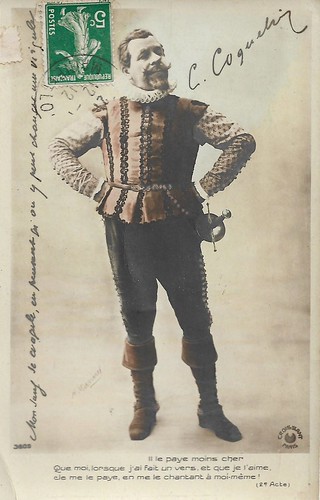
French postcard by Croissant, Paris, no. 3609. Photo: Henri Manuel, Paris. Constant Coquelin in the second act of the play 'Cyrano de Bergerac' (1897).
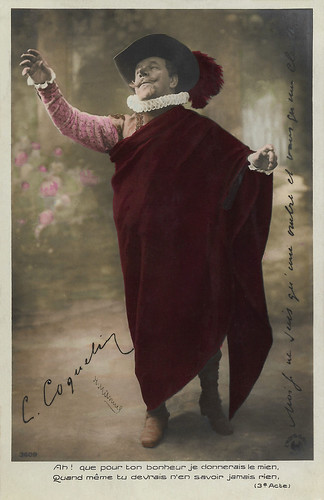
French postcard by Croissant, Paris, no. 3609. Photo: Henri Manuel, Paris. Constant Coquelin in the third act of the play 'Cyrano de Bergerac' (1897).
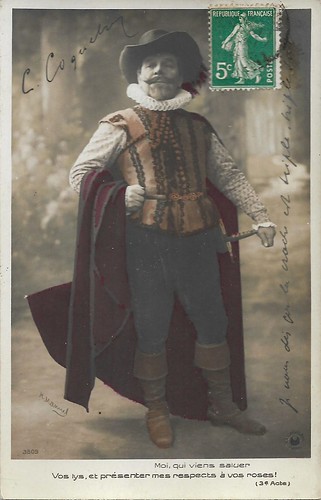
French postcard by Croissant, Paris, no. 3609. Photo: Henri Manuel, Paris. Constant Coquelin in the third act of the play 'Cyrano de Bergerac' (1897).
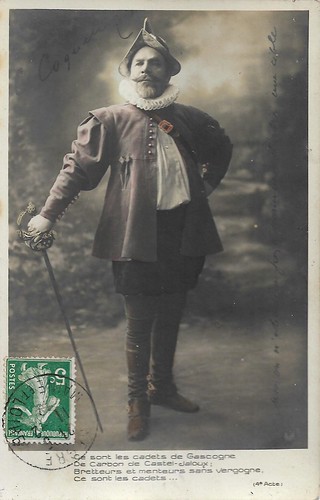
French postcard by Croissant, Paris, no. 3609. Photo: Henri Manuel, Paris. Constant Coquelin in the fourth act of the play 'Cyrano de Bergerac' (1897).
Benoît-Constant Coquelin (1841-1909), known as Coquelin aîné (Coquelin the Elder), was a French actor, who was known as one of the greatest theatrical figures of the age. He entered the Comédie-Française in 1860, became sociétaire there in 1864, left in 1887 to go on European and American tours, and returned as a Pensionnaire between 1890 and 1892. Despite the strict rules of the Comédie not play afterwards on other stages, Coquelin had a triumph in 1897 with Edmond Rostand's 'Cyrano de Bergerac' and would play it many times. In 1900, when he was almost sixty, Coquelin toured in America with Sarah Bernhardt and appeared on Broadway's Garden Theatre in a production of 'Cyrano de Bergerac' (Bernhardt played Roxane). On their return to France, he continued with his old colleague to appear in 'L'Aiglon', at the Théâtre Sarah Bernhardt. For his booming voice and his lyrical and fiery temperament, Rostand wrote 'Chantecler', but the actor died in 1909 before it could be performed by him. The only film of Coquelin senior was an early sound film shot by the Lumiere brothers operator Felix Mesguich in 1900, though some sources state Clement Maurice as the responsible one. It was a scene from Edmond Rostand's duel scene from 'Cyrano de Bergerac', a role Coquelin sr. had created in 1897. The film was shown at the Phono-Cinema-Theatre in Paris during the famous 1900 Exposition. After the exposition closed, Mesguich took the films on a three-month tour all over Europe. In 1930, the film was found back, together with early sound films. In 1952 it was inserted in the film Cinema parlant 1900.
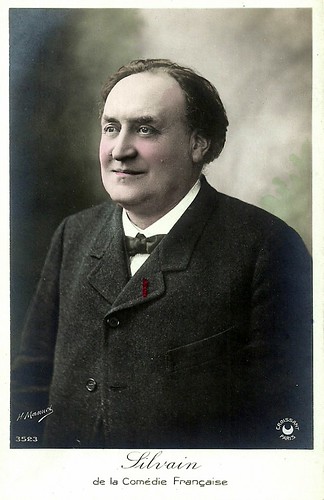
French postcard by Croissant, Paris, no. 3523. Photo: Henri Manuel. Caption: Silvain de la Comédie Française.
Eugène Sylvain or Eugène Silvain (1851-1930), also known as Sylvain and Silvain, was a prominent French stage actor, though he is best remembered as the evil bishop Cauchon in Carl Theodor Dreyer’s silent film La passion de Jeanne d’Arc (1928). He entered the Comédie Française in 1878, became a Sociétaire in 1883, a Doyen between 1916 and 1928, and he left the company in 1928.

French postcard by Croissant, Paris, no. 3523. Photo: Henri Manuel. Caption: Leloir de la Comédie Française.
Louis Leloir a.k.a. Leloir (1860-1909), originally Louis Pierre Sallot, was a French actor, and a Sociétaire of the Comédie-Française between 1889 and 1909. Parallel to his stage career, he was appointed teacher at the Conservatoire de musique et déclamation in 1894, and vice-president of the Société des artistes dramatiques in 1897. Because of his courageous behaviour during the 1900 fire at the Comédie-Française, he was awarded the Légion d'Honneur the same year. When he died in 1909, he was a board member of the Comédie Française and one of its regular stage directors. Little is known about Leloir's involvement in the cinema. He may have written the script for the Film d'Art production Louis XI (André Calmettes, 1910), starring Emile Dehelly, while he may have made the poster for the Film d'Art production Un Duel sous Richelieu (André Calmettes, 1908), starring Henry Krauss.
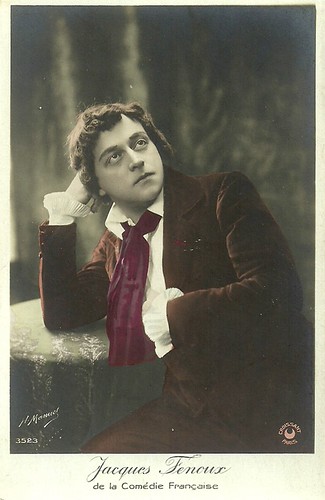
French postcard by Croissant, Paris, no. 3523. Photo: Henri Manuel, Paris. Caption: Jacques Fenoux de la Comédie Française.
Jacques Fenoux entered the Comédie-Française in 1895, became a Sociétaire in 1906, retired in 1924, and became a Sociétaire Honoraire in 1925. As the site of the Comédie states: "Fenoux was the type of a conscientious member, able to move effortlessly from one job to another, from small to large parts. He was appointed honorary member in 1925 but continued to play until his last days. He barely disappeared two weeks after having last interpreted Bazile, from 'The Barber of Seville'." As far is known, his only film performance was in Jacques de Féraudy's Molière, sa vie, son oeuvre (1922), in which actors of the Comédie-Française can be seen rehearsing plays by Molière.

French postcard by Croissant, Paris, no. 3523. Photo: Henri Manuel, Paris. Caption: Truffier de la Comédie Française.
Jules Truffier (1856-1943) was a respected actor of the Comédie-Française. As far as known, he didn't act in a film, but as a teacher at the Conservatoire (from 1906 onward) he trained future screen actors. Jules Truffier's father, who had acted before starting in commerce, and was befriended with the actors Got and Delaunay, let his son study at the Parisian Conservatoire from 1873. Truffier jr. entered the Comédie-Française in 1875, became a Sociétaire there in 1888, retired in 1913, and in 1922 became a Sociétaire Honoraire. All in all, he played some 150 parts in an almost 40 years time span. In 1914, he quit acting in 'Maître Favilla', an adaptation by himself of a piece by George Sand, and in the same year he became manager of the Études classiques de la Comédie-Française, so the staging of the classic repertory by the Comédie. This he did until 1918/1919. Among his pupils at the Conservatoire, where he taught between 1906 and 1929, were Berthe Bovy, Pierre Dux, and Pierre Blanchar.
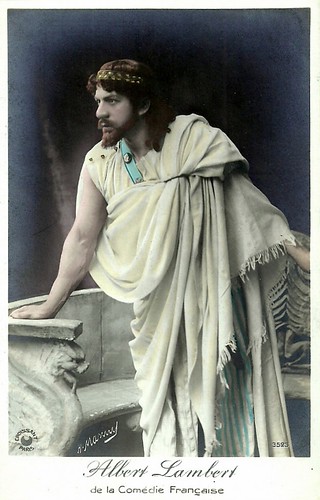
French postcard by Croissant, Paris, no. 3523. Photo: H. Manuel. Albert Lambert as Orestes.
Albert Lambert (1865-1941), aka Albert Lambert fils, was a French stage and screen actor, who was for a long time part of the Comédie-Française. He also played in several early French Film d’Art films, first of all in L'Assassinat du Duc de Guise (1908).
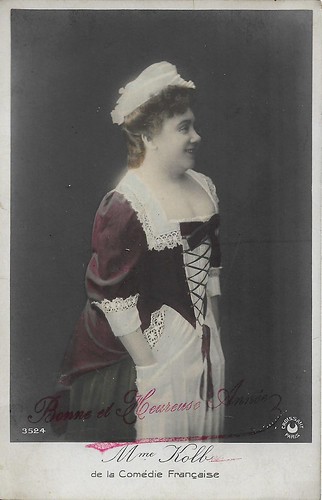
French postcard by Croissant, Paris, no. 3524. Photo Henri Manuel, Paris. Caption: Mme. Kolb de la Comédie Française.
Thérèse Kolb (1856-1935) was a reputed French stage actress, who also had a career in French silent cinema. Born Marie-Thérèse Kolb in Altkirch (Alsace, Haut-Rhin), she won the first prize at the Conservatoire de Paris and began to act at the Théâtre de l'Odéon with Coquelin the Elder and Sarah Bernhardt, whom she followed on a tour around the United States in 1882. Kolb entered the Comédie-Française in 1898, before becoming the 338th member in 1904. She was named an honorary member in 1923. While she had one occasional first role in 1912 in Le Fils prodigue by Camille de Morlhon, from the late 1910s Kolb started a steady second career in acting in French silent cinema. In 1921-1922, she was Mme Bicard in four Le Bouif comedies with Tramel, directed by Henri Pouctal and Louis Osmont, while she also had major parts in L'ami Fritz (René Hervil, 1920), Blanchette (Hervil, 1921), Yasmina (André Hugon, 1927), L'île d'amour (Berthe Dagmar, Jean Durand, 1929), L'appassionata (André Liabel, Léon Mathot, 1929), and Le crime de Sylvestre Bonnard (André Berthomieu, 1929). In 1935 Thérèse Kolb died in Levallois-Perret (Seine) and she was buried in the Altkirch cemetery. She was the mother of Jean Kolb.

French postcard by Croissant, Paris, no. 3609. Photo: Henri Manuel. Caption: M. Constant Coquelin.
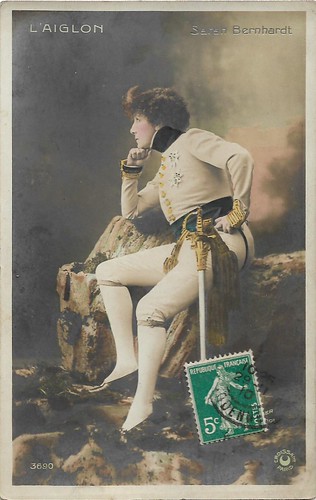
French postcard by Croissant, Paris, no. 3690. Photo: Paul Boyer. Sarah Bernhardt in the play 'L'Aiglon' (1900) by Edmond Rostand.
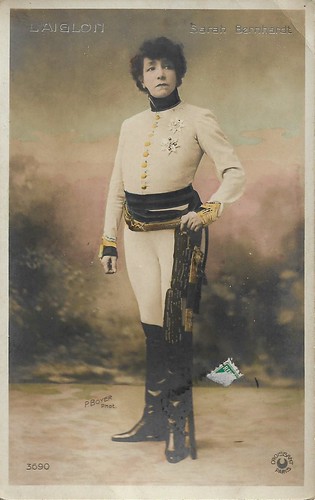
French postcard by Croissant, Paris, no. 3690. Photo: Paul Boyer. Sarah Bernhardt in the play 'L'Aiglon' (1900) by Edmond Rostand.
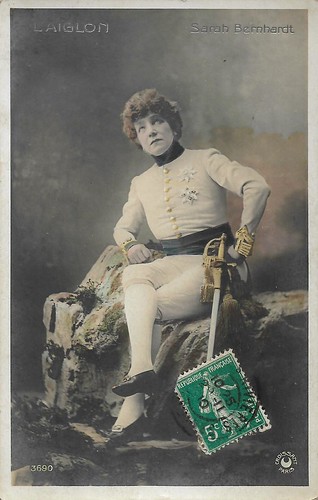
French postcard by Croissant, Paris, no. 3690. Photo: Paul Boyer. Sarah Bernhardt in the play 'L'Aiglon' (1900) by Edmond Rostand.
French vedette Sarah Bernhardt (1844-1923) has been referred to as 'the most famous actress in the history of the world'. She developed a reputation as a serious dramatic actress, earning her the nickname 'The Divine Sarah'. Bernhardt made her fame on the stages of Europe in the 1870s and was soon high in demand in both Americas too. And she was one of the first film stars. What a woman!
Sources: Comédie-Française (French), Filmographie Le Film d'Art by Eric Le Roy (French), Wikipedia (French) and IMDb.
And please, check out our earlier post on Croissant.
Constant Coquelin

French postcard by Croissant, Paris, no. 3609. Photo: Henri Manuel, Paris. Constant Coquelin in the first act of the play 'Cyrano de Bergerac' (1897).

French postcard by Croissant, Paris, no. 3609. Photo: Henri Manuel, Paris. Constant Coquelin in the first act of the play 'Cyrano de Bergerac' (1897).

French postcard by Croissant, Paris, no. 3609. Photo: Henri Manuel, Paris. Constant Coquelin in the second act of the play 'Cyrano de Bergerac' (1897).

French postcard by Croissant, Paris, no. 3609. Photo: Henri Manuel, Paris. Constant Coquelin in the third act of the play 'Cyrano de Bergerac' (1897).

French postcard by Croissant, Paris, no. 3609. Photo: Henri Manuel, Paris. Constant Coquelin in the third act of the play 'Cyrano de Bergerac' (1897).

French postcard by Croissant, Paris, no. 3609. Photo: Henri Manuel, Paris. Constant Coquelin in the fourth act of the play 'Cyrano de Bergerac' (1897).
Benoît-Constant Coquelin (1841-1909), known as Coquelin aîné (Coquelin the Elder), was a French actor, who was known as one of the greatest theatrical figures of the age. He entered the Comédie-Française in 1860, became sociétaire there in 1864, left in 1887 to go on European and American tours, and returned as a Pensionnaire between 1890 and 1892. Despite the strict rules of the Comédie not play afterwards on other stages, Coquelin had a triumph in 1897 with Edmond Rostand's 'Cyrano de Bergerac' and would play it many times. In 1900, when he was almost sixty, Coquelin toured in America with Sarah Bernhardt and appeared on Broadway's Garden Theatre in a production of 'Cyrano de Bergerac' (Bernhardt played Roxane). On their return to France, he continued with his old colleague to appear in 'L'Aiglon', at the Théâtre Sarah Bernhardt. For his booming voice and his lyrical and fiery temperament, Rostand wrote 'Chantecler', but the actor died in 1909 before it could be performed by him. The only film of Coquelin senior was an early sound film shot by the Lumiere brothers operator Felix Mesguich in 1900, though some sources state Clement Maurice as the responsible one. It was a scene from Edmond Rostand's duel scene from 'Cyrano de Bergerac', a role Coquelin sr. had created in 1897. The film was shown at the Phono-Cinema-Theatre in Paris during the famous 1900 Exposition. After the exposition closed, Mesguich took the films on a three-month tour all over Europe. In 1930, the film was found back, together with early sound films. In 1952 it was inserted in the film Cinema parlant 1900.

French postcard by Croissant, Paris, no. 3523. Photo: Henri Manuel. Caption: Silvain de la Comédie Française.
Eugène Sylvain or Eugène Silvain (1851-1930), also known as Sylvain and Silvain, was a prominent French stage actor, though he is best remembered as the evil bishop Cauchon in Carl Theodor Dreyer’s silent film La passion de Jeanne d’Arc (1928). He entered the Comédie Française in 1878, became a Sociétaire in 1883, a Doyen between 1916 and 1928, and he left the company in 1928.

French postcard by Croissant, Paris, no. 3523. Photo: Henri Manuel. Caption: Leloir de la Comédie Française.
Louis Leloir a.k.a. Leloir (1860-1909), originally Louis Pierre Sallot, was a French actor, and a Sociétaire of the Comédie-Française between 1889 and 1909. Parallel to his stage career, he was appointed teacher at the Conservatoire de musique et déclamation in 1894, and vice-president of the Société des artistes dramatiques in 1897. Because of his courageous behaviour during the 1900 fire at the Comédie-Française, he was awarded the Légion d'Honneur the same year. When he died in 1909, he was a board member of the Comédie Française and one of its regular stage directors. Little is known about Leloir's involvement in the cinema. He may have written the script for the Film d'Art production Louis XI (André Calmettes, 1910), starring Emile Dehelly, while he may have made the poster for the Film d'Art production Un Duel sous Richelieu (André Calmettes, 1908), starring Henry Krauss.

French postcard by Croissant, Paris, no. 3523. Photo: Henri Manuel, Paris. Caption: Jacques Fenoux de la Comédie Française.
Jacques Fenoux entered the Comédie-Française in 1895, became a Sociétaire in 1906, retired in 1924, and became a Sociétaire Honoraire in 1925. As the site of the Comédie states: "Fenoux was the type of a conscientious member, able to move effortlessly from one job to another, from small to large parts. He was appointed honorary member in 1925 but continued to play until his last days. He barely disappeared two weeks after having last interpreted Bazile, from 'The Barber of Seville'." As far is known, his only film performance was in Jacques de Féraudy's Molière, sa vie, son oeuvre (1922), in which actors of the Comédie-Française can be seen rehearsing plays by Molière.

French postcard by Croissant, Paris, no. 3523. Photo: Henri Manuel, Paris. Caption: Truffier de la Comédie Française.
Jules Truffier (1856-1943) was a respected actor of the Comédie-Française. As far as known, he didn't act in a film, but as a teacher at the Conservatoire (from 1906 onward) he trained future screen actors. Jules Truffier's father, who had acted before starting in commerce, and was befriended with the actors Got and Delaunay, let his son study at the Parisian Conservatoire from 1873. Truffier jr. entered the Comédie-Française in 1875, became a Sociétaire there in 1888, retired in 1913, and in 1922 became a Sociétaire Honoraire. All in all, he played some 150 parts in an almost 40 years time span. In 1914, he quit acting in 'Maître Favilla', an adaptation by himself of a piece by George Sand, and in the same year he became manager of the Études classiques de la Comédie-Française, so the staging of the classic repertory by the Comédie. This he did until 1918/1919. Among his pupils at the Conservatoire, where he taught between 1906 and 1929, were Berthe Bovy, Pierre Dux, and Pierre Blanchar.

French postcard by Croissant, Paris, no. 3523. Photo: H. Manuel. Albert Lambert as Orestes.
Albert Lambert (1865-1941), aka Albert Lambert fils, was a French stage and screen actor, who was for a long time part of the Comédie-Française. He also played in several early French Film d’Art films, first of all in L'Assassinat du Duc de Guise (1908).

French postcard by Croissant, Paris, no. 3524. Photo Henri Manuel, Paris. Caption: Mme. Kolb de la Comédie Française.
Thérèse Kolb (1856-1935) was a reputed French stage actress, who also had a career in French silent cinema. Born Marie-Thérèse Kolb in Altkirch (Alsace, Haut-Rhin), she won the first prize at the Conservatoire de Paris and began to act at the Théâtre de l'Odéon with Coquelin the Elder and Sarah Bernhardt, whom she followed on a tour around the United States in 1882. Kolb entered the Comédie-Française in 1898, before becoming the 338th member in 1904. She was named an honorary member in 1923. While she had one occasional first role in 1912 in Le Fils prodigue by Camille de Morlhon, from the late 1910s Kolb started a steady second career in acting in French silent cinema. In 1921-1922, she was Mme Bicard in four Le Bouif comedies with Tramel, directed by Henri Pouctal and Louis Osmont, while she also had major parts in L'ami Fritz (René Hervil, 1920), Blanchette (Hervil, 1921), Yasmina (André Hugon, 1927), L'île d'amour (Berthe Dagmar, Jean Durand, 1929), L'appassionata (André Liabel, Léon Mathot, 1929), and Le crime de Sylvestre Bonnard (André Berthomieu, 1929). In 1935 Thérèse Kolb died in Levallois-Perret (Seine) and she was buried in the Altkirch cemetery. She was the mother of Jean Kolb.

French postcard by Croissant, Paris, no. 3609. Photo: Henri Manuel. Caption: M. Constant Coquelin.
Sarah Bernhardt

French postcard by Croissant, Paris, no. 3690. Photo: Paul Boyer. Sarah Bernhardt in the play 'L'Aiglon' (1900) by Edmond Rostand.

French postcard by Croissant, Paris, no. 3690. Photo: Paul Boyer. Sarah Bernhardt in the play 'L'Aiglon' (1900) by Edmond Rostand.

French postcard by Croissant, Paris, no. 3690. Photo: Paul Boyer. Sarah Bernhardt in the play 'L'Aiglon' (1900) by Edmond Rostand.
French vedette Sarah Bernhardt (1844-1923) has been referred to as 'the most famous actress in the history of the world'. She developed a reputation as a serious dramatic actress, earning her the nickname 'The Divine Sarah'. Bernhardt made her fame on the stages of Europe in the 1870s and was soon high in demand in both Americas too. And she was one of the first film stars. What a woman!
Sources: Comédie-Française (French), Filmographie Le Film d'Art by Eric Le Roy (French), Wikipedia (French) and IMDb.
And please, check out our earlier post on Croissant.
No comments:
Post a Comment